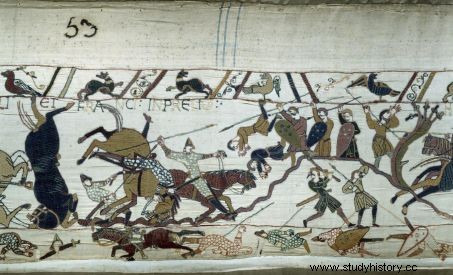The Franco-English "Entente cordiale" is reinforced by the unexpected loan within five years of the medieval treasure of the Bayeux Tapestry (Calvados).

Detail from the Bayeux Tapestry:The Norman fleet of William the Conqueror (1027-1087) approaching the English coast at Pevensey.
FIRST. The famous Bayeux Tapestry will leave France! Even if this exile, which should take place by 2022, is temporary, it is the first time in 950 years that this icon of medieval art will leave the national territory. It will indeed be loaned to Great Britain, according to information from Times . A spectacular loan which should be announced by Emmanuel Macron, this Thursday, January 18, during the 35 e Franco-British summit.
The precious "tapestry" - which is in fact an embroidery in woolen thread - recounts in great detail the conquest of England by William the Conqueror (1027-1087) and relates the different stages of the accession to the throne of this king. Norman, as well as the preparations for his invasion of the island. Composed of nine panels assembled in a single piece, this 11th century work, also known as the Tapestry of Queen Mathilde, resembles a gigantic comic strip 68.38 m long by 50 cm wide which is ends with the defeat of King Harold Godwinson (1022-1066) at the Battle of Hasting (1066), William's rival. Fifty-eight scenes of great realism, in which more than 1,500 characters evolve, reconstruct both the crossing of the Channel by Norman navigators and the chaos of battles. Representations of dismembered bodies and equestrian assaults alternate with almost rural themes, rather inspired by fables, present on the edges of the canvas, and sometimes mixed with fantastic creatures.
Detail from the Bayeux Tapestry, (Calvados), recounting the battle of Hastings, in 1066. Credits:Josse/Leemage/AFP
The first written reference to the existence of this embroidery dates from 1476, but little is known about the conditions in which it was made. Exhibited in the city of Bayeux (Calvados), at the Center Guillaume le Conquérant, the precious linen canvas has rarely been moved. We know that Napoleon had asked to see her in 1803, when he was preparing an invasion of England. It would then have been exhibited in Paris in 1944, during the Second World War, before returning to Bayeux. Emmanuel Macron's decision to loan this national treasure, listed as a historic monument since 1970 and on UNESCO's Memory of the World Register since 2007, comes after attempts to exhibit it in Britain failed. . According to the Times , a previous request would have been made before the coronation of Queen Elizabeth in 1953 and another for the 900th anniversary of the Battle of Hastings in 1966.
No one knows at this time where the embroidery will be exhibited in the UK, "months of discussions between culture department officials in London and Paris " yet to come to fruition, still according to The Times. Nor the duration of this loan. The British will therefore have for the first time in their history the privilege of admiring the original rather than the copy, since a replica of the Bayeux tapestry, made by 35 Victorian embroiderers in 1885, is on display at the Reading Museum (Berkshire ). Forging new ties with Prime Minister Theresa May's Britain in these Brexit times , is a consummate art of petit point diplomacy.

